Share on:
The water cycle
Earth's water is always in movement, and the natural water cycle, also known as the hydrologic cycle, describes the continuous movement of water on Earth.
The water cycle is a complex system that includes many different processes. Liquid water evaporates into water vapor, condenses to form clouds, and precipitates back to earth in the form of rain and snow.
Water in different phases moves through the atmosphere. Liquid water flows across land (runoff), into the ground (infiltration), and through the ground. Groundwater moves into plants and evaporates from plants into the atmosphere (transpiration). Solid ice and snow can turn directly into gas (sublimation).
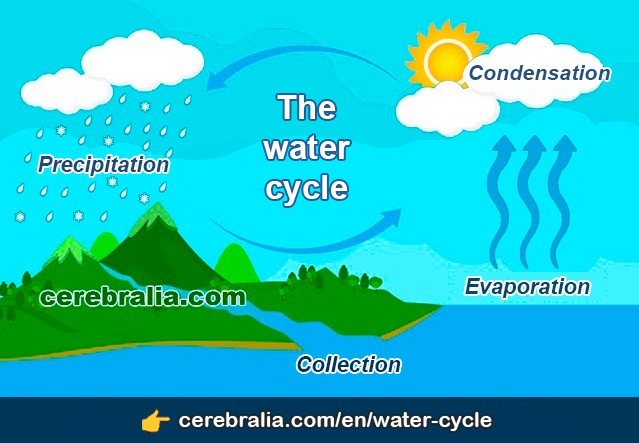
Earth's water is always in movement and is always changing states, from liquid to vapor to ice and back again. The water cycle has been working for billions of years and all life on Earth depends on it continuing to work; the Earth would be a pretty stale place to live without it.
1) Evaporation
Evaporation is the process by which water changes from a liquid to a gas or vapor. Evaporation is the primary pathway that water moves from the liquid state back into the water cycle as atmospheric water vapor.
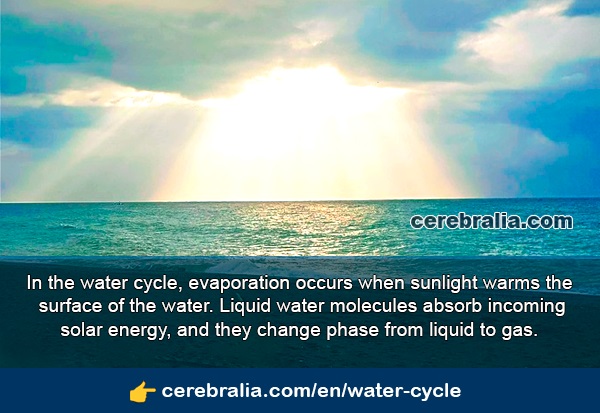
Evaporation happens when a liquid is heated. As the molecules at the surface of a liquid absorb heat, they begin to move around more quickly. This gives them the energy to break the bonds that connect them to other water molecules. When the molecules are moving fast enough, they are able to "escape." They leave the surface of the liquid as gas molecules.
Evaporation is not the only process that can change a substance from a liquid to a gas. The same change can occur through boiling.
As a liquid is heated, its molecules absorb heat and move faster. When the liquid starts to boil, bubbles of vapor form within the liquid and rise to the surface. Part of the water seems to disappear, but it actually moves into the air as a gas called water vapor.
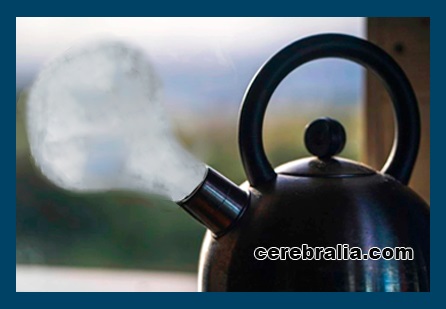
Studies have shown that the oceans, seas, lakes, and rivers provide nearly 90 percent of the moisture in the atmosphere via evaporation, with the remaining 10 percent being contributed by plant transpiration.
Transpiration.- The plant absorbs water from the soil through its roots and it is transported through plant tissues. That water is then used for metabolic and physiologic functions. The water eventually released to the atmosphere as vapor by leaves.
Sublimation.- Is the process by which water changes from a solid (ice or snow) to a gas, bypassing the liquid phase. Sublimation is a common way for snow to disappear quickly in arid climates.
Condensation
Condensation is the process by which water vapor in the air is changed into liquid water. Condensation is crucial to the water cycle because it is responsible for the formation of clouds. These clouds may produce precipitation. Condensation is the opposite of evaporation.
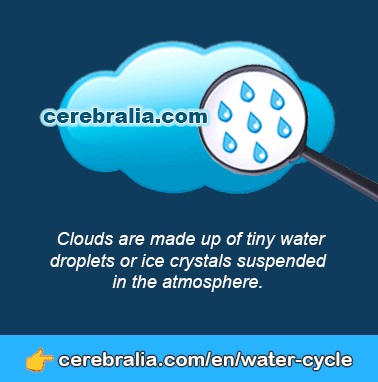
Condensation happens when molecules in a gas cool down. As the molecules lose heat, they lose energy and slow down. They combine with tiny dust particles called condensation nuclei to form cloud droplets, which combine and grow and develop into clouds. This process occurs higher in the sky where the air is cooler.
An example of condensation can be seen when drops of water form on the outside of a glass of ice water. The drops seem to appear from nowhere. However, they actually form from water vapor in the air. The dew that forms on grass overnight is another example of condensation.
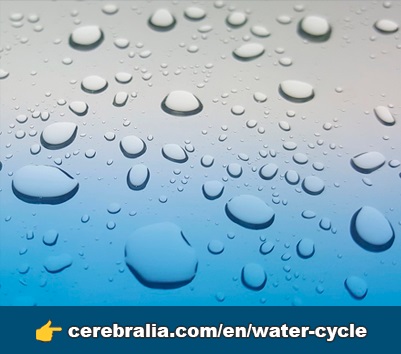
And why is it colder higher up? Generally, air pressure, is the reason. At higher altitudes, there is less air above, and, thus, less air pressure pressing down. The barometric pressure is lower, and lower barometric pressure is associated with fewer molecules per unit volume. Therefore, the air at higher altitudes is less dense. This means cooler air.
3) Precipitation
The clouds floating overhead contain cloud droplets which are small drops of condensed water. These droplets are way too small to fall as precipitation, but they are large enough to form visible clouds. Most of the condensed water in clouds does not fall as precipitation because their fall speed is not large enough to overcome updrafts which support the clouds.
When the cloud droplets combine to form heavier cloud drops which can no longer "float" in the surrounding air, it can fall out of the cloud as precipitation. Most precipitation occurs as rain, but also includes snow, hail, graupel and sleet.
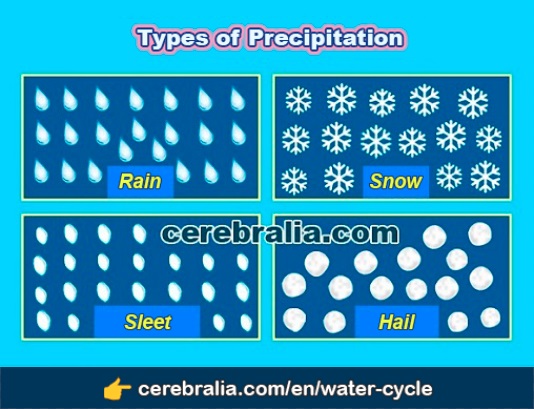
Precipitation is a major component of the water cycle, and is responsible for depositing fresh water on the planet.
How much water falls during a storm? You might be surprised at the number of gallons of water that fall from the sky in even a small but intense storm. One inch of rain falling on just a single acre results in 27,154 gallons of water on the landscape.
4) Collection
The fallen precipitation is collected in bodies of water such as rivers, lakes and oceans, from where it will eventually evaporate back into the air, beginning the cycle all over again. How it is collected, depends on where it land.
In cold climates, the precipitation may build up on land as snow, ice or glaciers. If temperatures rise, the ice will melt to liquid water and then soak into the ground, or flow into rivers or the ocean.
Water that reaches land directly may flow across the ground and collect in the oceans, rivers or lakes. This water is called «surface run-off». Some of the precipitation will instead infiltrate into the soil, from where it will slowly move through the ground until eventually reaching a river or the ocean.
🥇 Find out more: 🙂
✅ What's the difference between boiling and evaporation?
✅ Cloud seeding stimulates rainfall. How does it work?

